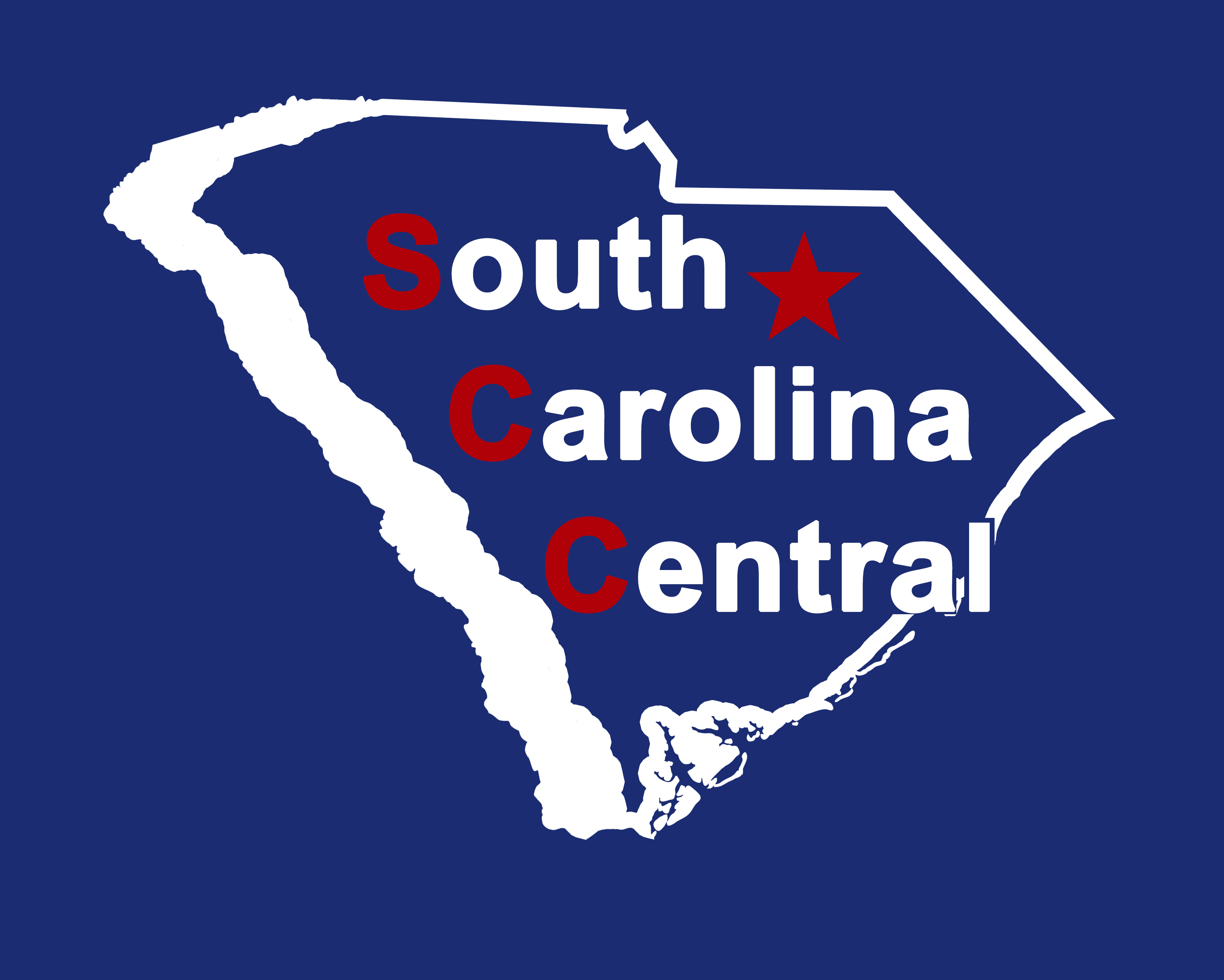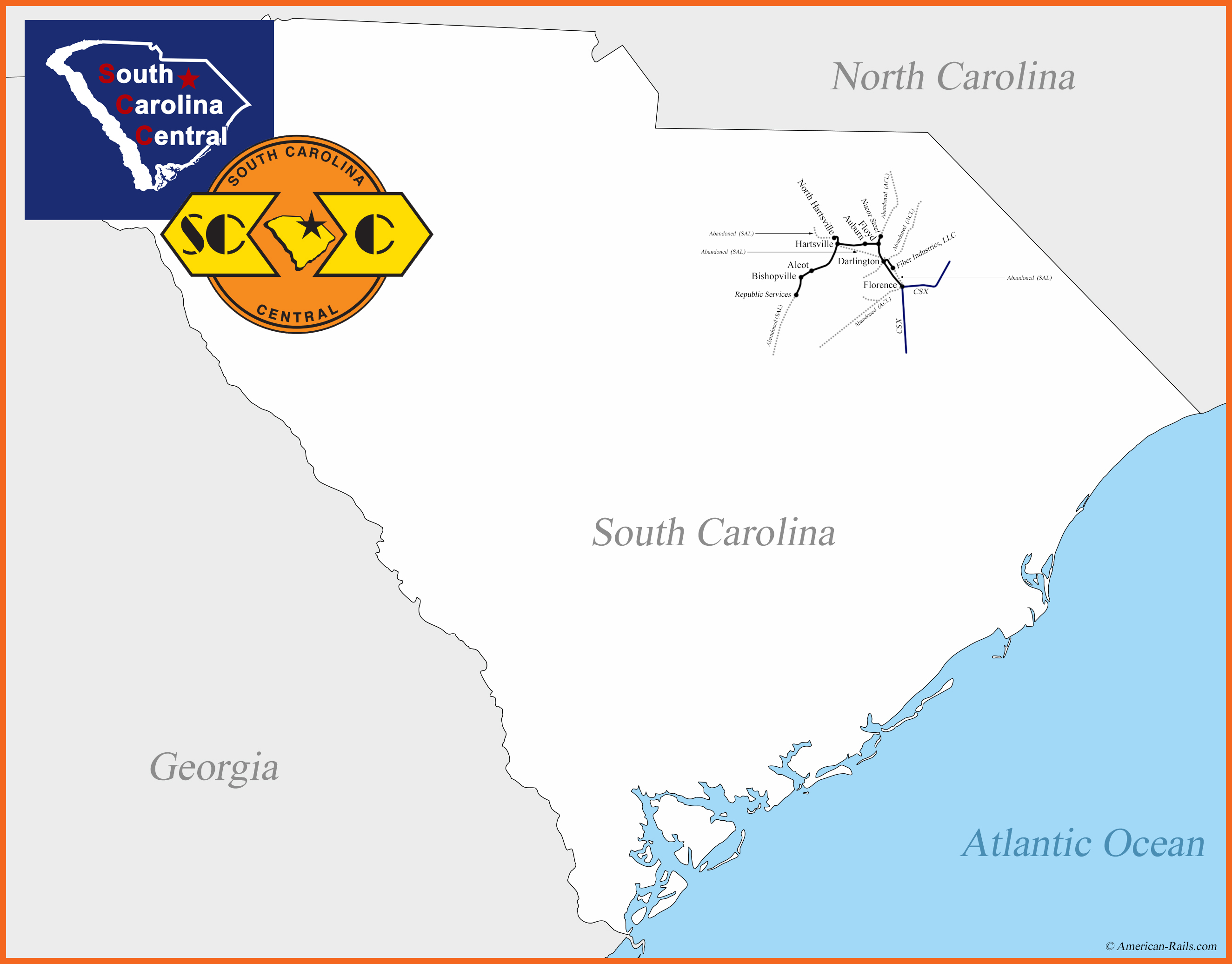South Carolina Central Railroad: Launched By RailTex In 1987
Last revised: August 30, 2024
By: Adam Burns
The South Carolina Central Railroad (SCRF), a Genesee & Wyoming property, is a
small short line that is headquartered in Darlington, South Carolina on
original Atlantic Coast Line and Seaboard Air Line trackage with a system
that now stretches 51 miles in length.
The history of these lines dates back more than 100 years and in some ways it is perhaps surprising they survived at all after the turbulent years of the 1970s and 1980s.
Presently, the SCRF's interchange point is at Florence with CSX. Unfortunately, despite numerous lines once radiating into and out of the region many (all of ACL or SAL ancestry) have been abandoned.
The South Carolina Central does not have an extensive customer base but does have a diverse traffic base. Due to the significant amount of traffic the railroad now handles the future of this short line looks very promising.
History, the South Carolina Central was not always a G&W property; its heritage can be traced back to the late 1980's to a now-defunct short line conglomerate, RailTex.
This company emerged on the scene in 1977 and grew into one of the largest such companies of its day. It was eventually sold to RailAmerica on February 4, 2000. RA, of course, would go on to join Genesee & Wyoming in 2012.
Photos
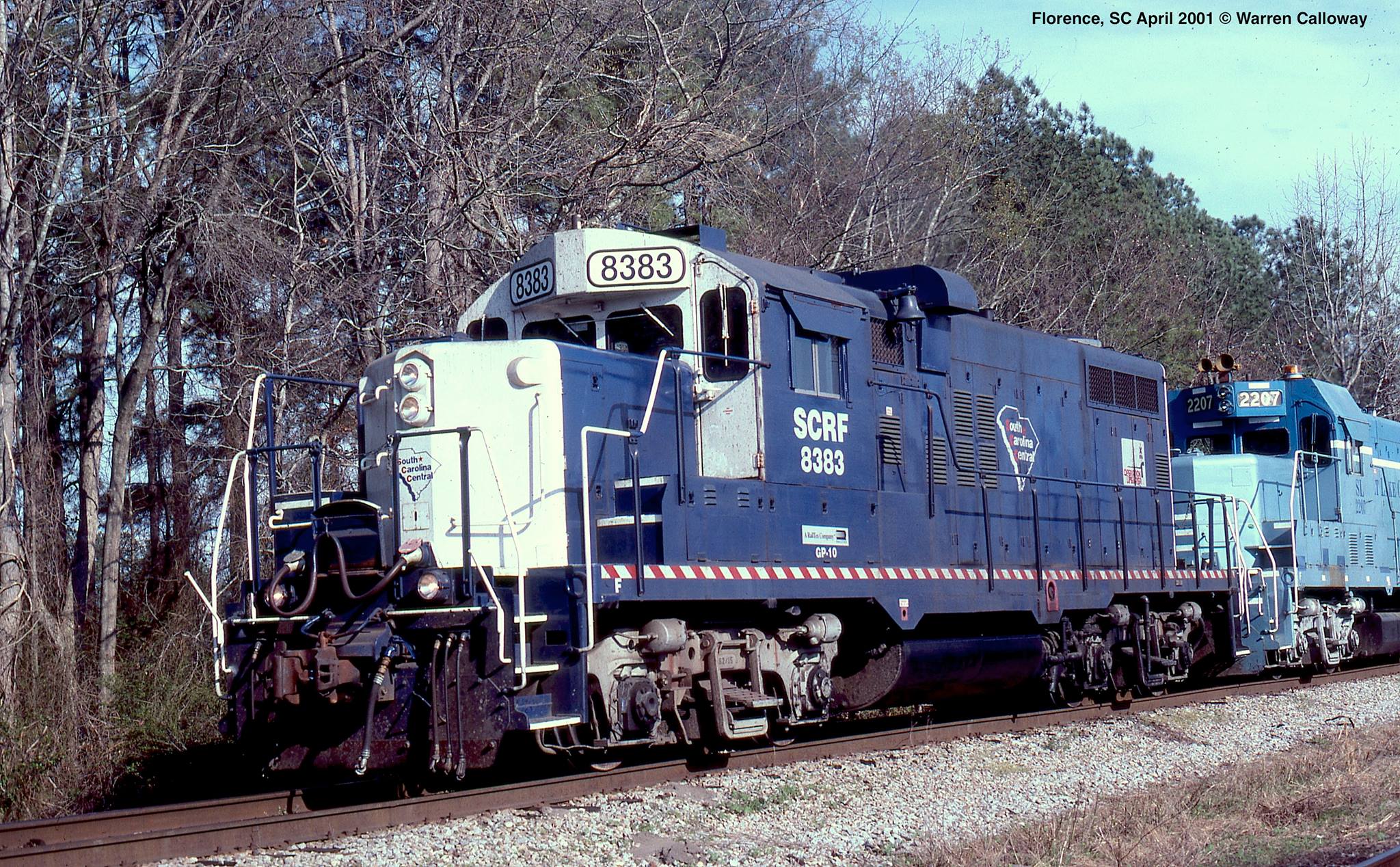 South Carolina Central GP10 #8383 is seen here at Florence, South Carolina in April of 2001. The unit began its career as Pittsburgh & Lake Erie GP7 #5728. Warren Calloway photo.
South Carolina Central GP10 #8383 is seen here at Florence, South Carolina in April of 2001. The unit began its career as Pittsburgh & Lake Erie GP7 #5728. Warren Calloway photo.History
The South Carolina Central Railroad dates back to 1987 when CSX Transportation was interested in shedding low-density branch lines all across its system massive eastern system.
Looking to diversify its holdings, short line specialist RailTex stepped and purchased the trackage naming the new railroad the South Carolina Central.
The company was founded by Bruce Flohr who was originally only in leasing railcars. While this business was profitable he looked to widen his revenue stream and launched the small San Diego & Imperial Valley Railroad on March 8, 1984 (still in service under Genesee & Wyoming).
This new operation worked out an agreement with the Metropolitan Transit Development Board of San Diego to provide freight service over its San Diego & Arizona Eastern Railway.
Flohrs employed three strategies to increase business; aggressive marketing away from the primary rail line, acquiring non-union railroads, and purchasing second-hand locomotives.
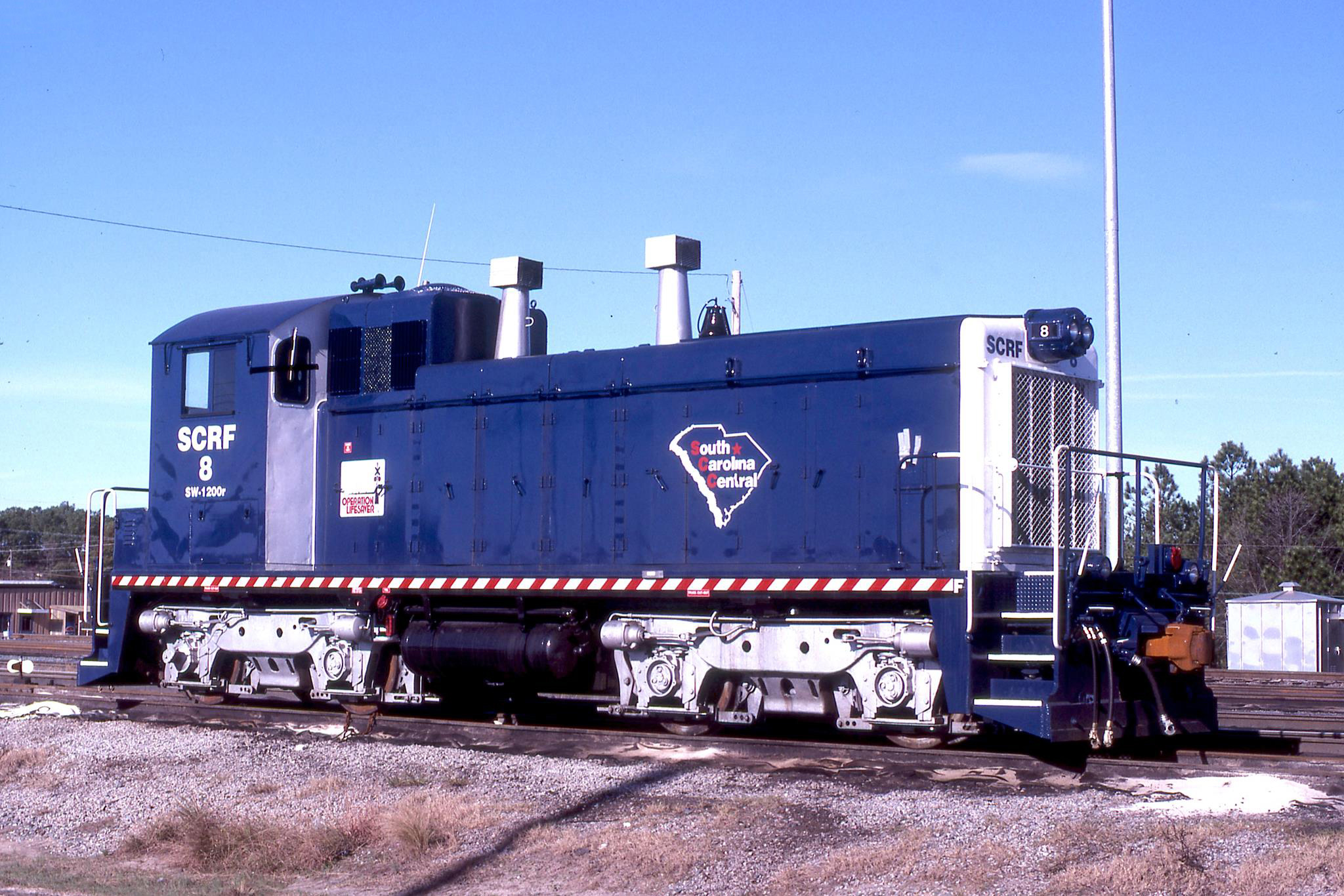 One of the South Carolina Central's few switchers, SW1200r #8, is seen here in Hamlet, North Carolina during April of 1998. Warren Calloway photo.
One of the South Carolina Central's few switchers, SW1200r #8, is seen here in Hamlet, North Carolina during April of 1998. Warren Calloway photo.This tactic proved very successful; when RailAmerica acquired the company it owned 26 railroads that totaled more than 4,100 route miles.
The modern short line movement continues to employ many of Flohr's practices today. The South Carolina Central's track is located in the northern part of the state and consists of two primary lines; one between Society Hill and Cheraw, and another much larger line between Florence and Bishopville.
The shorter section of track was the oldest constructed, dating back to the Cheraw & Darlington Railroad. The C&D was chartered in 1849 to connect its namesake cities and with strong financial backing had completed its main line between the two towns by 1853.
The company was severely damaged by the Civil War although a few years after the war had ended it rebuilt its entire line and extended it as far south as Florence, giving it a system covering 38.4 miles according to a later Seaboard Coast Line timetable.
By 1892 the railroad had reached Wadesboro, North Carolina after it acquired the Cheraw & Salisbury Railroad. This gave the C&D a line stretching exactly 63.0 miles and by 1898 it came under the control of the Atlantic Coast Line Railroad.
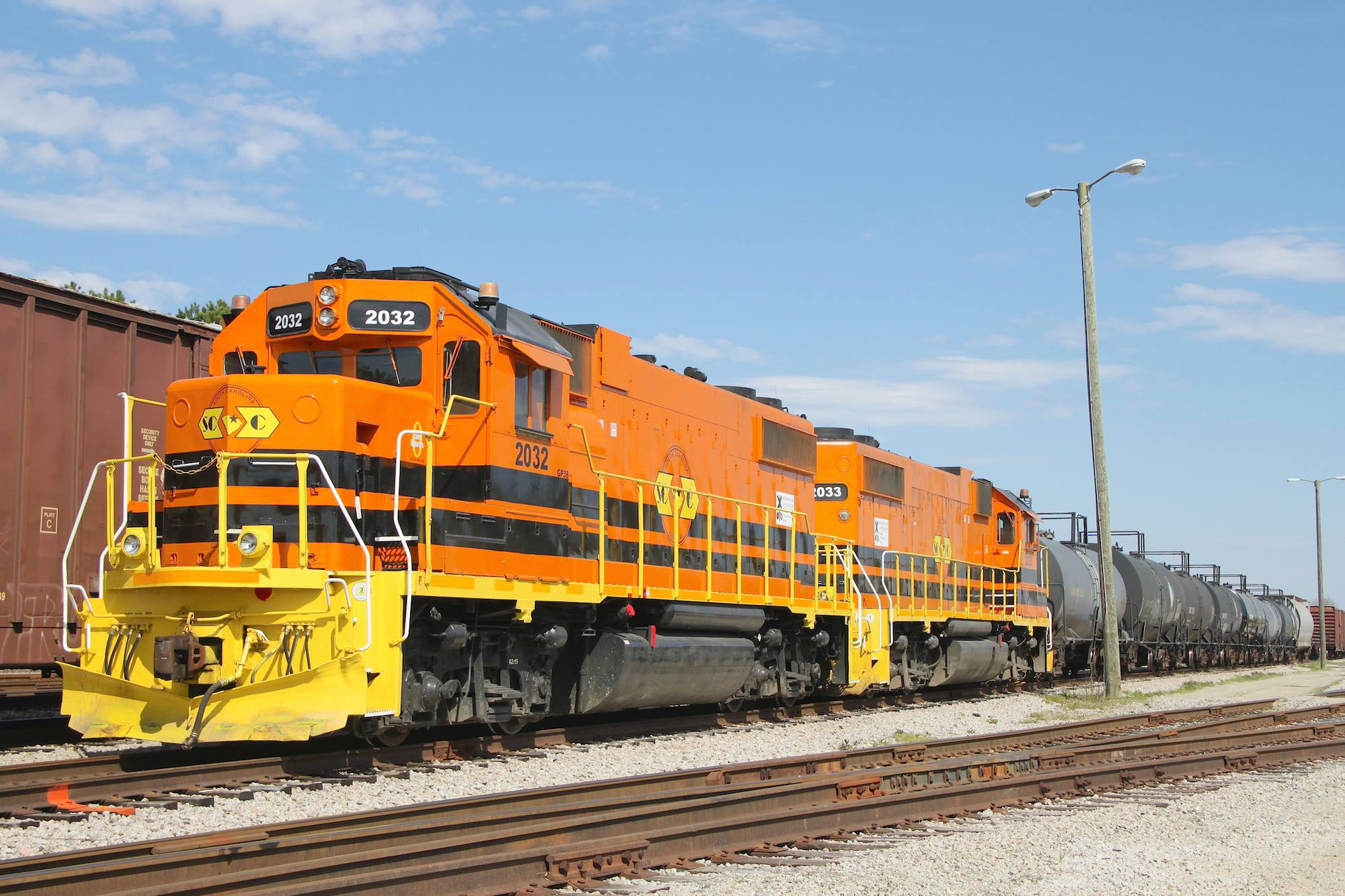 The present-day South Carolina Central Railroad with a pair of GP38's painted in parent Genesee & Wyoming's colors at Floyd, South Carolina on April 1, 2014. Warren Calloway photo.
The present-day South Carolina Central Railroad with a pair of GP38's painted in parent Genesee & Wyoming's colors at Floyd, South Carolina on April 1, 2014. Warren Calloway photo.After the ACL had merged with the Seaboard Air Line the entire line between Florence and Wadesboro remained in operation although it was later abandoned between Floyd and Society Hill (a section of line totaling 11.7 miles in length), and between Wadesboro and Cheraw (this section totaled 24.6 miles in length).
As for the second, larger section of track it also has components of original ACL trackage, with the rest former SAL property.
The section of line between Floyd and Hartsville was constructed by the Hartsville Railroad in 1889, meant to connect the Hartsville with the C&D and totaled exactly 10.0 miles in length.
The C&D purchased the railroad in 1895 before, again, it came under the control of the ACL a few years later.
Logo
Finally, the only section of original SAL trackage runs between Bishopville and Hartsville and totals exactly 16.7 miles in length according to the SAL's official timetable.
When CSX Corporation was formed in 1980 the new company slowly integrated the new railroads part of the merger, a process not completed until CSX Transportation was born in 1987.
System Map
The entirety of the company's southern network was comprised of the former Seaboard System lines, which included the old Atlantic Coast Line and Seaboard Air Line properties.
CSX was quick to shed corridors it deemed superfluous or poorly performing. This was not isolated to the conglomerate's southern lines; significant portions of the former Baltimore & Ohio as well as sections of the Chesapeake & Ohio were either sold or abandoned.
The properties now comprising the SCRF were always secondary lines and quickly discarded under CSX.
Locomotive Roster
| Road Number | Model Type | Builder | Year Built | Notes |
|---|---|---|---|---|
| 8 | SW1200R | EMD | 11/1942 | Built as Port Huron & Detroit NW2 #8. |
| 21 | GP9 | EMD | 7/1956 | Built as New Haven #1201, became Penn Central/Conrail #7221. |
| 75 | GP10 | EMD | 12/1958 | Built as Illinois Central GP9 #9375. |
| 77 | GP10 | EMD | 12/1958 | Built as Illinois Central GP9 #9377. |
| 2027 | GP10 | EMD | 1/1951 | Built as Santa Fe GP7 #2664. |
| 2032 | GP38-2 | EMD | 1978 | Built as Florida East Coast. |
| 2033 | GP38-2 | EMD | 4/1978 | Built as Florida East Coast #505. |
| 2053 | GP7u | EMD | 11/1953 | Built as Santa Fe GP7 #2882. |
| 2130 | GP7u | EMD | 12/1952 | Built as Santa Fe GP7 #2825. |
| 2147 | GP38-2 | EMD | 10/1973 | Built as Southern #5098, became NS #5098. |
| 2160 | GP7u | EMD | 5/1952 | Built as Santa Fe GP7 #2729. (Sold) |
| 2185 | GP7u | EMD | 8/1952 | Built as Santa Fe GP7 #2742. (Sold) |
| 5905 | GP9 | EMD | 12/1954 | Built as Chesapeake & Ohio #5905. (Sold) |
| 6097 | GP9 | EMD | 7/1956 | Built as Chesapeake & Ohio #6097. (Sold) |
| 6187 | GP9 | EMD | 11/1956 | Built as Chesapeake & Ohio #6187. |
| 6412 | GP40-2 | EMD | 10/1972 | Built as Detroit, Toledo & Ironton #412. (Leased/Returned) |
| 6415 | GP40-2 | EMD | 10/1973 | Built as Detroit, Toledo & Ironton #415. (Leased/Returned) |
| 6439 | GP9 | EMD | 5/1955 | Built as Baltimore & Ohio #6439. (Sold) |
| 6440 | GP9 | EMD | 5/1955 | Built as Baltimore & Ohio #6440. (Sold) |
| 6541 | GP9 | EMD | 6/1957 | Built as Baltimore & Ohio #6541. (Sold) |
| 6550 | GP9 | EMD | 7/1957 | Built as Baltimore & Ohio #6550. (Sold) |
| 6555 | GP9 | EMD | 7/1957 | Built as Baltimore & Ohio #6555. (Sold) |
| 7307 | SD18 | EMD | 1/1963 | Built as Chesapeake & Ohio #1807. (Sold) |
| 7309 | SD18 | EMD | 1/1963 | Built as Chesapeake & Ohio #1809. (Sold) |
| 8483 | GP10 | EMD | 4/1953 | Built as Pittsburgh & Lake Erie GP7 #5728. (Sold) |
| 9490 | GP40-2LW | GMDD | 7/1974 | Built as Canadian National #9490. (Leased/Returned) |
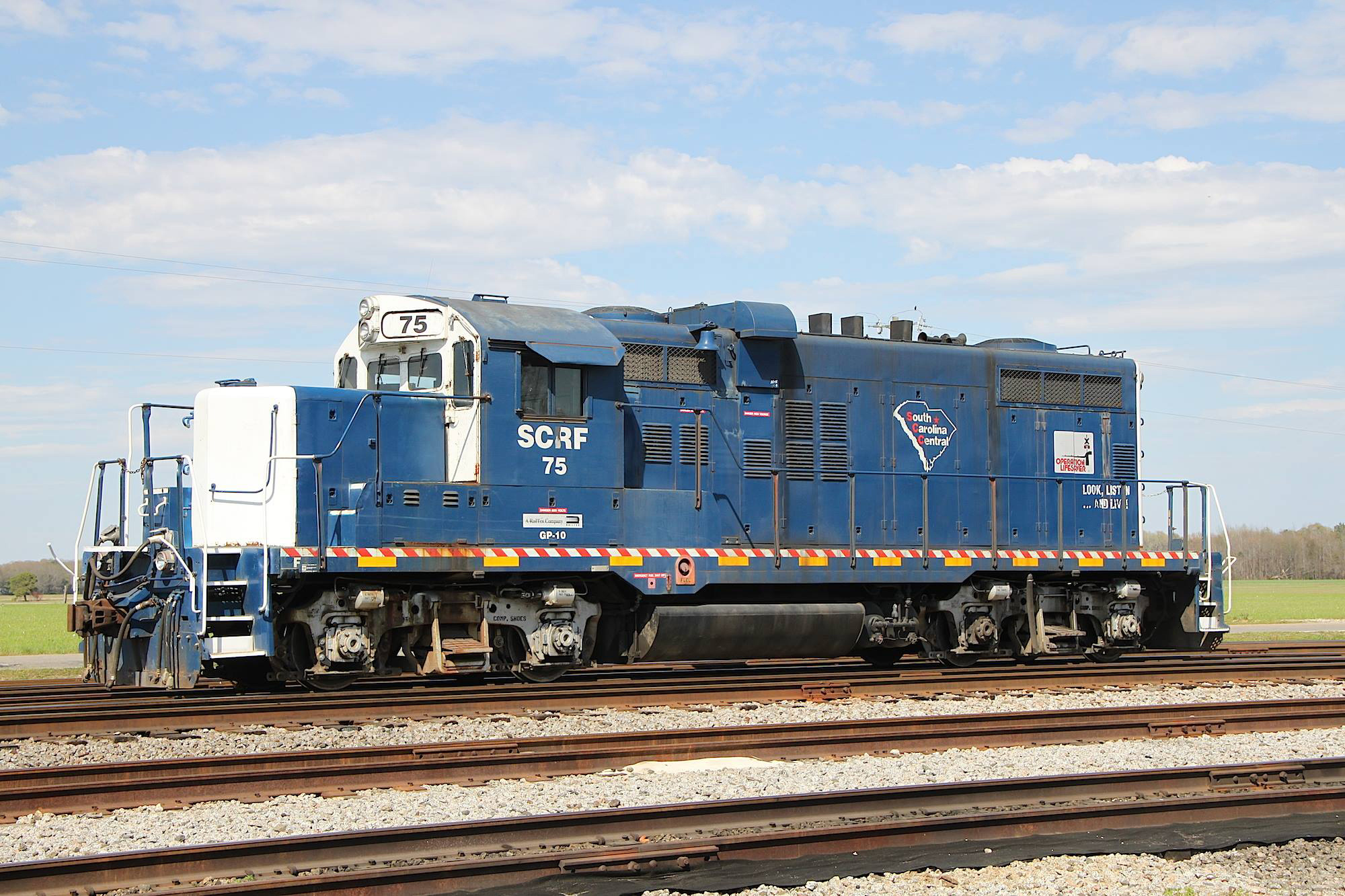 South Carolina Central GP10 #75 at Floyd, South Carolina on April 1, 2014. The unit began its career in 1958 as Illinois Central GP9 #9375. Warren Calloway photo.
South Carolina Central GP10 #75 at Floyd, South Carolina on April 1, 2014. The unit began its career in 1958 as Illinois Central GP9 #9375. Warren Calloway photo.In all, after the abandonments the South Carolina Central operates a system stretching 51 miles in length today (its system offers more than 120 miles of active railroad although I can only guess that this includes all sidings and spurs).
In any event, after operating the SCRF for 13 years RailTex was purchased by RailAmerica, Inc. (itself an operator of numerous short lines) in February of 2000 giving it a handful of new railroads.
The road again changed hands in July of 2012 when Genesee & Wyoming bought out RailAmerica. Today, the company's classic blue and white livery with the state logo continues to disappear as locomotives are repainted into G&W's ubiquitous orange.
Its future appears strong although changing market conditions can always affect smaller roads like the SCRF. Its primary traffic base currently includes steel, chemicals, trash, plastics, and some agriculture.
In addition, its Rail Link, Inc. subsidiary offers switching, track maintenance, locomotive/car maintenance, and more.
Recent Articles
-
Connecticut - Murder Mystery - Dinner Train Rides
Dec 11, 25 01:06 PM
All aboard the intrigue express! One location in Connecticut typically offers a unique and thrilling experience for both locals and visitors alike, murder mystery trains. -
New Hampshire - Murder Mystery - Dinner Train Rides
Dec 11, 25 12:55 PM
The state's murder mystery trains stand out as a captivating blend of theatrical drama, exquisite dining, and scenic rail travel. -
Tennessee - Murder Mystery - Dinner Train Rides
Dec 11, 25 12:48 PM
Amidst the rolling hills and scenic landscapes of Tennessee, an exhilarating and interactive experience awaits those with a taste for mystery and intrigue.

